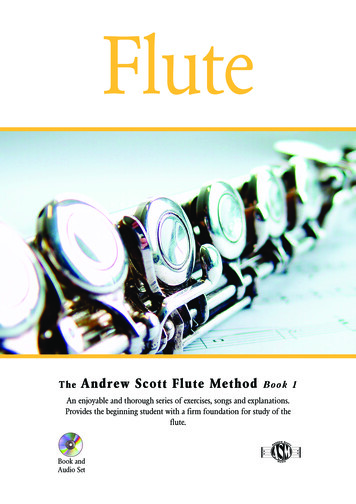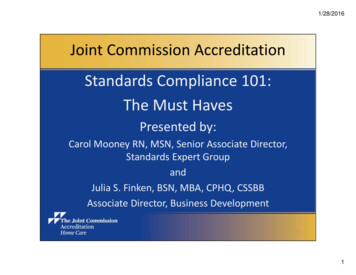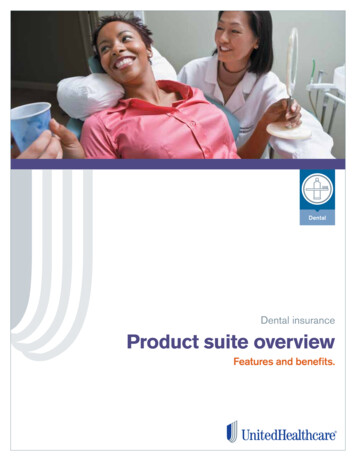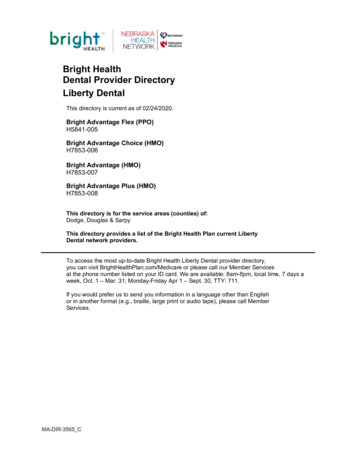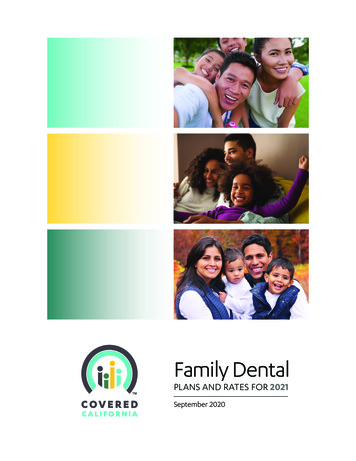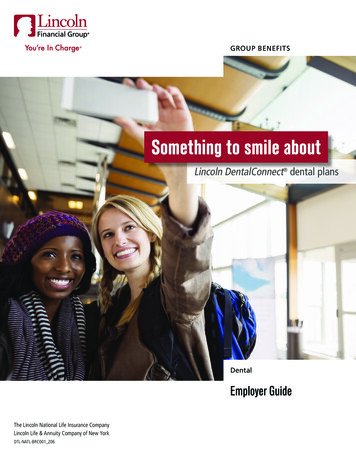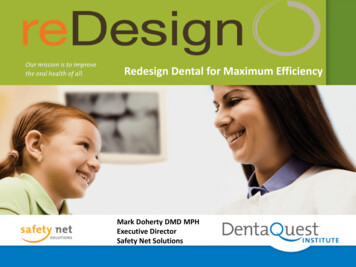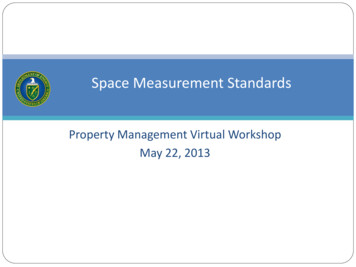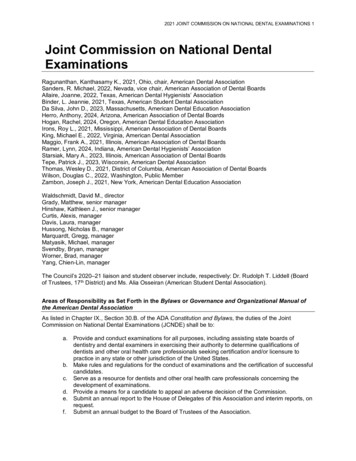
Transcription
2021 JOINT COMMISSION ON NATIONAL DENTAL EXAMINATIONS 1Joint Commission on National DentalExaminationsRagunanthan, Kanthasamy K., 2021, Ohio, chair, American Dental AssociationSanders, R. Michael, 2022, Nevada, vice chair, American Association of Dental BoardsAllaire, Joanne, 2022, Texas, American Dental Hygienists’ AssociationBinder, L. Jeannie, 2021, Texas, American Student Dental AssociationDa Silva, John D., 2023, Massachusetts, American Dental Education AssociationHerro, Anthony, 2024, Arizona, American Association of Dental BoardsHogan, Rachel, 2024, Oregon, American Dental Education AssociationIrons, Roy L., 2021, Mississippi, American Association of Dental BoardsKing, Michael E., 2022, Virginia, American Dental AssociationMaggio, Frank A., 2021, Illinois, American Association of Dental BoardsRamer, Lynn, 2024, Indiana, American Dental Hygienists’ AssociationStarsiak, Mary A., 2023, Illinois, American Association of Dental BoardsTepe, Patrick J., 2023, Wisconsin, American Dental AssociationThomas, Wesley D., 2021, District of Columbia, American Association of Dental BoardsWilson, Douglas C., 2022, Washington, Public MemberZambon, Joseph J., 2021, New York, American Dental Education AssociationWaldschmidt, David M., directorGrady, Matthew, senior managerHinshaw, Kathleen J., senior managerCurtis, Alexis, managerDavis, Laura, managerHussong, Nicholas B., managerMarquardt, Gregg, managerMatyasik, Michael, managerSvendby, Bryan, managerWorner, Brad, managerYang, Chien-Lin, managerThe Council’s 2020–21 liaison and student observer include, respectively: Dr. Rudolph T. Liddell (Boardof Trustees, 17th District) and Ms. Alia Osseiran (American Student Dental Association).Areas of Responsibility as Set Forth in the Bylaws or Governance and Organizational Manual ofthe American Dental AssociationAs listed in Chapter IX., Section 30.B. of the ADA Constitution and Bylaws, the duties of the JointCommission on National Dental Examinations (JCNDE) shall be to:a. Provide and conduct examinations for all purposes, including assisting state boards ofdentistry and dental examiners in exercising their authority to determine qualifications ofdentists and other oral health care professionals seeking certification and/or licensure topractice in any state or other jurisdiction of the United States.b. Make rules and regulations for the conduct of examinations and the certification of successfulcandidates.c. Serve as a resource for dentists and other oral health care professionals concerning thedevelopment of examinations.d. Provide a means for a candidate to appeal an adverse decision of the Commission.e. Submit an annual report to the House of Delegates of this Association and interim reports, onrequest.f. Submit an annual budget to the Board of Trustees of the Association.
2021 JOINT COMMISSION ON NATIONAL DENTAL EXAMINATIONS 2Advancing ADA Strategic Goals and Objectives: Agency Programs, Projects, Results andSuccess MeasuresThe Joint Commission is an agency of the ADA that maintains independent authority to pursue activitiesin accordance with the duties assigned to it within the ADA Constitution and Bylaws. As such, the JointCommission determines its own corresponding goals and objectives. The information presented below isderived from the JCNDE’s strategic plan, with corresponding updates provided in italics after eachstatement.JCNDE Strategic Goals and Key ObjectivesGoal One: Develop and conduct highly reliable, state of the art examinations to support decisions aboutlicensure and certification of members of the oral health care team.1. Conduct the National Board Dental Examination (NBDE) Part I through July 30, 2020 and Part IIthrough July 31, 2022, and ensure policies for the orderly, secure and fair administration of theseexaminations are implemented. Due to COVID-19 restrictions, the availability of NBDE Part I wasextended through December 31, 2020; candidate eligibilities to challenge these examinationswere similarly extended through December 31, 2020 to permit orderly, secure, and fairadministrations.2. Conduct the National Board Dental Hygiene Examination (NBDHE) and ensure policies for theorderly, secure and fair administration of this examination are implemented. A short-form editionof the NBDHE was validated and published in 2020 to facilitate testing during the COVID-19global pandemic.3. Successfully transition to the Integrated National Board Dental Examination (INBDE) program byAugust 1, 2022 and ensure policies for the orderly, secure and fair administration of thisexamination are implemented. The INBDE was successfully launched on August 1, 2020; over500 INBDE administrations occurred in 2020.4. Further integrate best practices in testing into JCNDE examinations by introducing multi-stageadaptive testing, 3-parameter logistic item response theory for the NBDHE, and the developmentof an image bank, to support the validity of JCNDE programs. The JCNDE continues to pursueeach of the aforementioned innovations.5. Explore the potential use of other innovations in testing, such as automatic item generation,simulations (“gamification” of testing), video, partial credit scoring and the use of testing windows,and develop recommendations on whether to pursue these testing modalities. The JCNDEcontinues to pursue each of the aforementioned innovations.6. Engage key stakeholders and communities of interest in discussions of potential newexaminations and testing modalities. To help address the needs of stakeholders and communitiesof interest, the JCNDE released the Dental Licensure Objective Structured Clinical Examination(DLOSCE) in 2020, and is considering initiating development of a Dental Hygiene LicensureObjective Structured Clinical Examination (DHLOSCE) in 2021.Goal Two: Serve as a trusted and independent resource on assessment for the oral health careprofessions to state dental boards and other key stakeholders.1. Develop a strategic communications plan to guide JCNDE’s communications and engagementwith key stakeholder groups (i.e., stakeholder mapping, understanding stakeholders’ interestsand needs, reframing the messaging around the “why,” increasing understanding of the range ofresources JCNDE can provide). The JCNDE has formed a standing committee known as theCommittee on Communications and Stakeholder Engagement to pursue and monitor its strategiccommunication plan in relation to stakeholder groups.
2021 JOINT COMMISSION ON NATIONAL DENTAL EXAMINATIONS 32. Provide high quality tools, credible information and guidance about best practices in testing andassessment to support state boards in carrying out their role regarding the licensure andcertification of oral health care professionals. The JCNDE delivered numerous presentations todental boards across the US in 2020, concerning the merits of the DLOSCE, and the benefits itprovides over existing clinical licensure examinations.3. Increase understanding of the mission and work of the JCNDE among members of the ADAHouse of Delegates, and the importance of JCNDE’s position and reputation as a credible andindependent testing agency. The JCNDE delivered a webinar on the DLOSCE in 2020 for dentalsocieties, with the goal of sharing DLOSCE information and the JCNDE’s mission and vision toserve as the nation’s leading resource for supporting standards of oral healthcare professionalsthrough valid, reliable and fair assessments for licensure and certification.4. Reduce incidents of cheating and sharing of exam questions among test takers by increasingunderstanding of the impact on the exam’s cost and validity, stressing professionalism, andraising awareness of the potential consequences of such actions. The JCNDE continues toundertake efforts to communicate the aforementioned message to candidates, and it continues toenforce its regulations in situations where violations occur.5. Utilize Commissioners as peer ambassadors to increase understanding of the JCNDE and buildstronger relationships with state dental boards. The JCNDE has presented to dental boards onnumerous occasions in 2020 and 2021, and many of those presentations includedCommissioners serving as peer ambassadors.Goal Three: Strengthen the governance of JCNDE to increase responsiveness, credibility andindependence.1. Undertake a comprehensive review of the JCNDE’s governing documents (e.g., bylaws, standingrules, exam regulations, composition, and structure) and make recommendations to strengthenthe governance systems and structures as appropriate. The JCNDE completed the indicatedreview, resulting in significant Bylaws changes for the JCNDE in 2019; the JCNDE continues toreview its governing documents on an annual basis.2. Identify opportunities to increase the agility and nimbleness of the JCNDE’s governance anddecision-making processes. The JCNDE reviews its governance documents and practicesannually, making changes as appropriate to facilitate operations and enhance its ability toachieve its strategic goals.3. Socialize recommendations for changes to the governance of the JCNDE with the ADA Board ofTrustees and the ADA House of Delegates before submitting proposed changes for considerationby the 2019 House of Delegates. The JCNDE socialized its recommendations for changes to theADA Board of Trustees as indicated; the changes were successfully approved by the ADA Houseof Delegates in 2019; the JCNDE is grateful for the support of the House as the JCNDE continuesto pursue its Bylaws mandated duties.Emerging Issues and TrendsThe following communicate the most recent actions of the Joint Commission since its prior Annual Reportto the House of Delegates:1. The Joint Commission continues to pursue actions in support of the Integrated National BoardDental Examination (INBDE), including the following:A. Implementing the INBDE score report to provide remediation information for candidateswho fail the INBDE.
2021 JOINT COMMISSION ON NATIONAL DENTAL EXAMINATIONS 4B. Directing staff to implement the DTS Hub NBDE results reporting format to facilitateboard interpretation of test results.C. Directing staff to implement the monthly INBDE reports for dental education programs, tofacilitate understanding of students’ performance in areas measured by the INBDE.D. Directing staff to implement the annual INBDE school performance report for dentaleducation programs, to summarize candidate performance on a yearly basis.E. Establishing a defensible, criterion-referenced performance standard for the INBDE, toserve as the minimum level of performance a candidate must demonstrate on the INBDEin order to pass and be considered safe to practice with respect to dental cognitive skills.2. The Joint Commission continues to take action to ensure it has sufficient, highly capable andknowledgeable test constructors to build rigorous examination content:A. Approved the transitioning of National Board Dental Examination Part II test constructorsto serve as Integrated National Board Dental Examination test constructors in the JointCommission’s 2021 INBDE Test Constructor Pool.3. The Joint Commission continues to pursue efforts in support of its strategic direction. Thisincludes the following:A. Directing staff to develop a business plan to understand potential interest in developing aDental Hygiene Licensure Objective Structured Clinical Examination (DHLOSCE), andthe anticipated requirements to develop, implement, and provide ongoing support forsuch an examination.B. Adopting revisions to its Rules and Policies in alignment with the strategic direction of theJCNDE, including incorporating provisions that add a new Dental Hygiene member to theBoard of Commissioners, with the new member’s term beginning in 2020.C. Prioritizing communications for the following critical examinations in 2020: DLOSCE,INBDE, and NBDHE.4. The Joint Commission monitors its examinations closely to ensure they are psychometrically validand performing as intended. In January 2021, the JCNDE held a meeting via conference call todiscuss Failure Rates for New and Modified Examinations. Following discussion, the JointCommission took the following action:A. Directing staff to continue to closely monitor National Board Examination failure rates andreport back to the Committee on Research and Development in March 2021.5. The next annual meetings of the JCNDE will be held on June 23, 2021 and June 29, 2022. Theannual State Dental Board Forum (SDBF) will precede the meetings of the JCNDE (occurring inthe same week indicated).6. Performance Trends: The following provides performance information for each of theexaminations of the JCNDE.NBDE Part I: Table 1 presents performance trends for NBDE Part I over the past 10 years, while Figure 1provides a graphic depiction of administration volume. Table 1 shows steady growth in the number offirst-time candidates from accredited and non-accredited programs taking the NBDE Part I from 2011to 2016 and variability from 2017 to 2019. The total number of administrations rose from 8,098 in 2011to 10,185 in 2019. This represents an overall increase of 2,087 candidates (i.e., 25.8%). The significantdecrease in the number of administrations from 2019 to 2020 represents the confluence of three majorevents occurring in 2020: the discontinuation of the NBDE Part I program, the launch of the INBDE as areplacement examination program, and the COVID-19 pandemic.A new and more rigorous NBDE Part I standard was introduced in November 2016, resulting in higherfailure rates and corresponding increases in the number of candidates needing to retake the NBDE Part I
2021 JOINT COMMISSION ON NATIONAL DENTAL EXAMINATIONS 5from 2017 to 2019. Additional information about the NBDE Part I standard setting activities is provided inthe NBDE Technical Report. The new performance standard represented an increase in the level ofcognitive skills required by entry-level dentists, in order to practice safely. Under this updated standard,the number of repeating candidates from accredited programs increased from 669 in 2017 to 972 in2019. Across the ten year period indicated, failure rates for first-time candidates from accreditedprograms ranged from 3.4% (2015) to 12.1% (2018). Failure rates for first-time candidates from nonaccredited programs were higher, ranging from 31.9% (2014) to 48.6% (2019). The total failure rate washigher in 2020 due to the greater proportion of candidates present from non-accredited programs.TABLE 1Numbers and Failure Rates for First-Time and Repeating CandidatesNBDE Part I
2021 JOINT COMMISSION ON NATIONAL DENTAL EXAMINATIONS 6NBDE Part II: Table 2 presents performance trends for the NBDE Part II over the past 10 years, whileFigure 2 provides a graphic depiction of administration volume. As shown in Table 2, the number of firsttime candidates from accredited programs decreased from 2011 to 2012, and then steadily increased toa ten-year high in 2020 (N 6,227) with some variability from 2017 to 2019. There have been considerablechanges in volume since 2011, ranging from a low of 4,803 candidates in 2012 to a high of 6,227 in 2020(i.e., a 29.6% increase). The total number of first-time and repeating candidates from non-accreditedprograms increased from 1,521 in 2011 to 1,717 in 2020. Comparing the number of totaladministrations occurring in 2011 (N 7,228) with 2020 (N 8,617) shows a 19.2% increase in overalladministration volume, with gains occurring involving candidates educated by both accredited and nonaccredited programs.Across the ten year period indicated, failure rates for first-time candidates from accredited programsranged from 5.1% (2011) to 9.7% (2019). Failure rates for first-time candidates from non-accreditedprograms were higher across the board, ranging from 23.3% (2019) to 42.0% (2015).
2021 JOINT COMMISSION ON NATIONAL DENTAL EXAMINATIONS 7TABLE 2Numbers and Failure Rates for First-Time and Repeating CandidatesNBDE Part II
2021 JOINT COMMISSION ON NATIONAL DENTAL EXAMINATIONS 8INBDE: Table 3 presents 2020 failure rates for the INBDE, the first year of operation of this important newexamination program. There were a total of 538 INBDE administrations in 2020. Among these, 274administrations were attempts by candidates educated by accredited programs, while 264administrations were attempts by candidates educated by non-accredited programs. The failure ratesare based on the performance standard and corresponding cut score established by the JCNDE in June2020. As shown, failure rates for first-time candidates from accredited and non-accredited programswere 1.0% and 38.8%, respectively. The total failure rate was 24.5%.In 2020, the first-time INBDE failure rate for candidates from accredited programs was lower than thecorresponding failure rates for NBDE Parts I and II. Failure rates for candidates educated by nonaccredited programs were rather consistent with historic trends. This suggests that candidates trained byCODA-accredited dental programs may have been especially well-prepared to challenge examinationsthat integrate the biomedical and clinical sciences. However, this did not seem to be the case forcandidates trained by non-accredited dental programs. This finding is a testimony to the importance ofstrong accrediting standards in service to the protection of the public health.TABLE 3Numbers and Failure Rates for First-time and Repeating CandidatesINBDENBDHE: Table 4 presents performance trends for the NBDHE over the past 10 years, while Figure 3provides a graphic depiction of administration volume. As shown in Table 4, the number of first-timecandidates from accredited programs increased from 6,968 in 2011 to 7,316 in 2019 (i.e., a 5%increase). The total number of candidates from non-accredited programs was relatively small comparedto the total number of candidates from accredited programs, representing approximately 3% ofadministrations occurring in 2011 and approximately 5% of administrations occurring in 2020 1. Comparingthe number of total administrations occurring in 2011 with 2020 shows an overall increase of 434 firsttime and repeating candidates from accredited and non-accredited programs (i.e., a 5.6% increase).Generally speaking, NBDHE total administration volume increased steadily from 2015 to 2019, but thendecreased in 2020. The decrease in volume from 2019 to 2020 is likely due to the impact of COVID-19.Failure rates have remained below 10% for all 10 years for first-time candidates from accreditedprograms. A more stringent NBDHE standard was introduced in January 2017, leading to higher failurerates in the years that followed. Additional information about the NBDHE standard setting activities isprovided in the NBDHE Technical Report. Failure rates for first-time candidates from non-accreditedprograms have varied considerably over the years. The rate for this group was highest in 2020 (44.0%)and lowest in 2013 (17.3%). Failure rates for first-time candidates from accredited programs increasedin 2020, likely due to candidate testing delays due to COVID-19 (closing of testing centers, socialdistancing requirements that reduced test center capacity, etc.), and candidates correspondinglyforgetting some of the material they had received training on as they waited to challenge the test.1Thetotal administration in 2020 consists of valid examination attempts from the full-length and short-form NBDHE.
2021 JOINT COMMISSION ON NATIONAL DENTAL EXAMINATIONS 9TABLE 4Numbers and Failure Rates for First-Time and Repeating CandidatesNBDHEDLOSCE: Table 5 presents failure rates for the DLOSCE. There were a total of 248 DLOSCEadministrations in 2020. Among these, 233 were from candidates trained by CODA-accredited dental
2021 JOINT COMMISSION ON NATIONAL DENTAL EXAMINATIONS 10programs, while the remaining 15 were from candidates trained by non-accredited programs. The failurerates are based on the performance standard and corresponding cut score established by the JCNDE inAugust 2020. As shown, failure rates for first-time candidates from accredited and non-accreditedprograms were 9.5% and 57.1%, respectively. The total failure rate was 12.5%TABLE 5Numbers and Failure Rates for First-Time and Repeating CandidatesDLOSCEOverall: Figure 4 provides a graphic depiction of overall test administration volume for the NationalBoard Examinations over the past 10 years. NBDE Part I and NBDE Part II total administrations haveshown greater variability over time, as compared to NBDHE total administrations, which have been fairlyconsistent. Administration volume for the NBDE Part I increased every year from 2011 to 2019.Administration volume for the NBDE Part II increased from 2012 to 2016, and then began to decreaseslightly after 2017. Administration volume for the NBDHE increased every year from 2011 to 2019, withthe exception of 2015. Administration volume decreased for all examinations in 2020, most likely due tothe COVID-19 pandemic. The INBDE and DLOSCE were both released in 2020, and therefore no trendinformation is provided in the chart below. There were 538 total INBDE administrations and 248 totalDLOSCE administrations in 2020.
2021 JOINT COMMISSION ON NATIONAL DENTAL EXAMINATIONS 11Testing Accommodations: In accordance with the Americans with Disabilities Act, the Joint Commissionprovides reasonable and appropriate accommodations for individuals with documented disabilities whodemonstrate a need for accommodations and request an accommodation prior to testing. Table 6presents performance trends for candidates from accredited programs who took Joint Commissionexaminations with accommodations over the past five years. As shown in Table 6, the number ofaccommodated examination attempts has remained relatively low for JCNDE programs. In 2020,accommodated examination attempts made up 2.0% of the total attempts for the NBDE Part I, 2.0% ofthe total attempts for the NBDE Part II, 1.7% of the total attempts for the INBDE, 1.0% of the totalattempts for the NBDHE, and 0.4% of the total attempts for the DLOSCE. Across the five-year periodindicated and across all examination programs, failure rates for accommodated first-time candidateswere higher than the failure rates obtained for first-time candidates experiencing standardadministrations (i.e., comparing Table 6 with Tables 1 through 5). The number of candidates receivingaccommodations was substantially less for the NBDHE program, as compared to the NBDE programs.
2021 JOINT COMMISSION ON NATIONAL DENTAL EXAMINATIONS 12TABLE 6Numbers and Failure Rates for Accredited CandidatesAttempts Involving AccommodationsResponses to House of Delegates ResolutionsThe Joint Commission did not receive any assignments from the ADA House of Delegates in 2020.Self-AssessmentThe Joint Commission is next scheduled to conduct a self-assessment in 2022.Policy ReviewWhile the Joint Commission is an agency of the ADA, it maintains independent authority to provide andadminister licensure exams in dentistry and dental hygiene. The Joint Commission maintains its policiesand procedures in the following documents: 1) Rules of the Joint Commission on National DentalExaminations, and 2) Operational and Policy Manual of the Joint Commission on National DentalExaminations. Changes to these documents were noted previously in this report.Commission MinutesFor more information on recent activities, see the Commission’s minutes on ADA.org.
annual State Dental Board Forum (SDBF) will occur on these same two days, directly preceding the meeting of the JCNDE. 5. Performance Trends: NBDE Part I: Table 4 presents performance trends for National Board Dental Examination Part I (NBDE Part I) over the past 10 years, while Figure 1 pro

